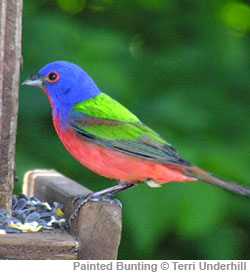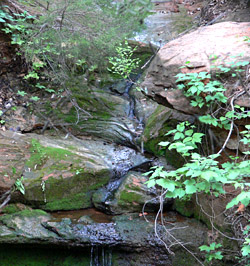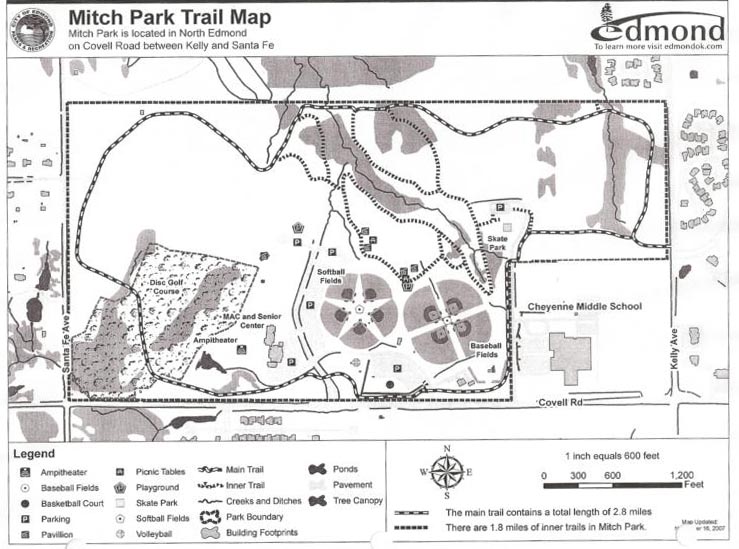LOCATION: Mitch Park – Edmond�
Contributed by Terri Underhill
35.411255 N 97.300477 W
Mitch Park 1501 W. Covell (between Kelly & Sante Fe) in NW Edmond OK.
Mitch is a 133-acre park which features several play-grounds including handicap accessible facilities, multiple use trials, basketball courts, pavilions, picnic tables, grills, amphitheater, Multiple Activity Center and sports fields with concession stand and restrooms.
 Getting to the park is easily accessible entering Covell from either Kelly or Santa Fe. You can take the main entrance into the park or follow the signs to the Mathis Skate Park on the east side of Mitch and north of Cheyenne Middle School. Both entrances are on Covell, along the south side of the park. Personally, I prefer to park and enter at the Skate Park since I can see and hear birds before I’ve even step foot on a trail.
Getting to the park is easily accessible entering Covell from either Kelly or Santa Fe. You can take the main entrance into the park or follow the signs to the Mathis Skate Park on the east side of Mitch and north of Cheyenne Middle School. Both entrances are on Covell, along the south side of the park. Personally, I prefer to park and enter at the Skate Park since I can see and hear birds before I’ve even step foot on a trail.
During the summer months you most likely will have already seen numerous Mississippi Kites soaring before you even enter the park. The wooded areas of Edmond are ideal for nesting and therefore loved by the Kites, Red Shouldered Hawk and numerous raptors. This is the habitat they prefer to breed and raise their young in.
During the summer months the first song you’ll want to listen for is the melodious song of the Painted Buntings. The males sing from the tops of the trees along the paved trails close to the area he nests in. The city of Edmond has done a fine job landscaping with native vegetation the birds and wildlife seem to thrive on. Throughout the park are benches and feeding stations where you can sit and enjoy the birds. I sometimes take along bird seed just in case the feeding stations have been depleted from the squirrels and rabbits.
The majority of the trails are paved and a newly-opened trail bridge opened during the winter of 2005. This new bridge is a great area to observe the Louisiana Waterthrush during the summer months. The Indigo Buntings and Blue Grosbeaks also enjoy this area and can be seen and heard during their summer stay.
 On the east side of the bridge and about 200′ south, there’s an unmarked opening in the dense trees. This is where you can walk down to a hidden waterfall and see the wonderful red rock our state is commonly known for. If you’ve ever had the urge to step back in nature but don’t want to take a drive to the country, this is great little place to check out. This beautiful area is a bird magnet in the heat of the day when the birds and critters come to bath and drink from the cool pools of water below the slow streaming fall.
On the east side of the bridge and about 200′ south, there’s an unmarked opening in the dense trees. This is where you can walk down to a hidden waterfall and see the wonderful red rock our state is commonly known for. If you’ve ever had the urge to step back in nature but don’t want to take a drive to the country, this is great little place to check out. This beautiful area is a bird magnet in the heat of the day when the birds and critters come to bath and drink from the cool pools of water below the slow streaming fall.
On the south end of the trails is a man-made overlook. This is a great place for getting a bird’s eye view of the trees tops from down below and even a closer look at a variety of birds. Native birds can be seen carrying nesting material in spring and later caring for their young in this densely wooded area. Mockingbirds, Thrashers, Bluebirds and many other fruit loving birds and wildlife can be seen enjoying the extremely popular fruit from the native Chickasaw Plums bordering many of the nicely paved trails. An assortment of Sparrows and many other birds use the dense thicket of Chickasaw Plums for nesting and a safe haven for their young. The thorny spurs give maximum protection against even the boldest of predators.
Species seen as of August 2021
eBird Basic Dataset. Version: EBD_relJul-2021. Cornell Lab of Ornithology, Ithaca, New York. Jul 2021.
| Accipiter sp. | Eurasian Collared-Dove | Pied-billed Grebe |
| American Coot | European Starling | Pileated Woodpecker |
| American Crow | Field Sparrow | Pine Siskin |
| American Goldfinch | Fish Crow | Purple Finch |
| American Kestrel | Fox Sparrow | Purple Martin |
| American Pipit | Franklin’s Gull | Red-bellied Woodpecker |
| American Redstart | Gadwall | Red-breasted Nuthatch |
| American Robin | Golden-crowned Kinglet | Red-eyed Vireo |
| American White Pelican | grackle sp. | Redhead |
| American Wigeon | Grasshopper Sparrow | Red-headed Woodpecker |
| Baird’s Sandpiper | Gray Catbird | Red-shouldered Hawk |
| Bald Eagle | Great Blue Heron | Red-tailed Hawk |
| Baltimore Oriole | Great Crested Flycatcher | Red-winged Blackbird |
| Barn Swallow | Great Egret | Ring-billed Gull |
| Barred Owl | Great Horned Owl | Ring-necked Duck |
| Bell’s Vireo | Greater Roadrunner | Rock Pigeon |
| Belted Kingfisher | Great-tailed Grackle | Ruby-crowned Kinglet |
| Bewick’s Wren | Green Heron | Ruby-throated Hummingbird |
| Black-and-white Warbler | gull sp. | Ruby-throated/Black-chinned Hummingbird |
| blackbird sp. | Haemorhous sp. | Savannah Sparrow |
| Black-chinned Hummingbird | Hairy Woodpecker | Say’s Phoebe |
| Blue Grosbeak | Harris’s Sparrow | Scissor-tailed Flycatcher |
| Blue Jay | hawk sp. | Sharp-shinned Hawk |
| Blue-gray Gnatcatcher | Hermit Thrush | Snowy Egret |
| Blue-winged Teal | Hooded Merganser | Song Sparrow |
| Brewer’s Blackbird | Horned Lark | sparrow sp. |
| Broad-winged Hawk | House Finch | Spotted Towhee |
| Brown Creeper | House Sparrow | Spotted x Eastern Towhee (hybrid) |
| Brown Thrasher | House Wren | Summer Tanager |
| Brown-headed Cowbird | House/Purple Finch | Swainson’s Hawk |
| Buteo sp. | hummingbird sp. | Swainson’s Thrush |
| Cackling Goose | Indigo Bunting | swallow sp. |
| Canada Goose | Killdeer | Tennessee Warbler |
| Canvasback | Lark Sparrow | Tufted Titmouse |
| Carolina Chickadee | Least Flycatcher | Turkey Vulture |
| Carolina Wren | LeConte’s Sparrow | Vesper Sparrow |
| Cattle Egret | Lesser Scaup | vireo sp. |
| Cedar Waxwing | Lincoln’s Sparrow | warbler sp. (Parulidae sp.) |
| Chimney Swift | Little Blue Heron | Warbling Vireo |
| Chipping Sparrow | Loggerhead Shrike | Western Kingbird |
| Chuck-will’s-widow | Louisiana Waterthrush | Western Meadowlark |
| Clay-colored Sparrow | Mallard | Western/Eastern Meadowlark |
| Cliff Swallow | Mallard (Domestic type) | white egret sp. |
| Common Grackle | Merlin | White-breasted Nuthatch |
| Common Nighthawk | Mississippi Kite | White-crowned Sparrow |
| Cooper’s Hawk | Mourning Dove | White-eyed Vireo |
| crow sp. | Nashville Warbler | White-throated Sparrow |
| Dark-eyed Junco | Northern Bobwhite | White-winged Dove |
| Dickcissel | Northern Cardinal | Wild Turkey |
| Double-crested Cormorant | Northern Flicker | Willow Flycatcher |
| Downy Woodpecker | Northern Harrier | Wood Duck |
| Downy/Hairy Woodpecker | Northern Mockingbird | woodpecker sp. |
| duck sp. | Northern Parula | Yellow Warbler |
| Eastern Bluebird | Northern Rough-winged Swallow | Yellow-bellied Sapsucker |
| Eastern Kingbird | Northern Shoveler | Yellow-billed Cuckoo |
| Eastern Meadowlark | nuthatch sp. | Yellow-breasted Chat |
| Eastern Phoebe | Olive-sided Flycatcher | Yellow-headed Blackbird |
| Eastern Towhee | Orange-crowned Warbler | Yellow-rumped Warbler |
| Eastern Wood-Pewee | Orchard Oriole | |
| Empidonax sp. | Painted Bunting | |
RELATED LINKS:

